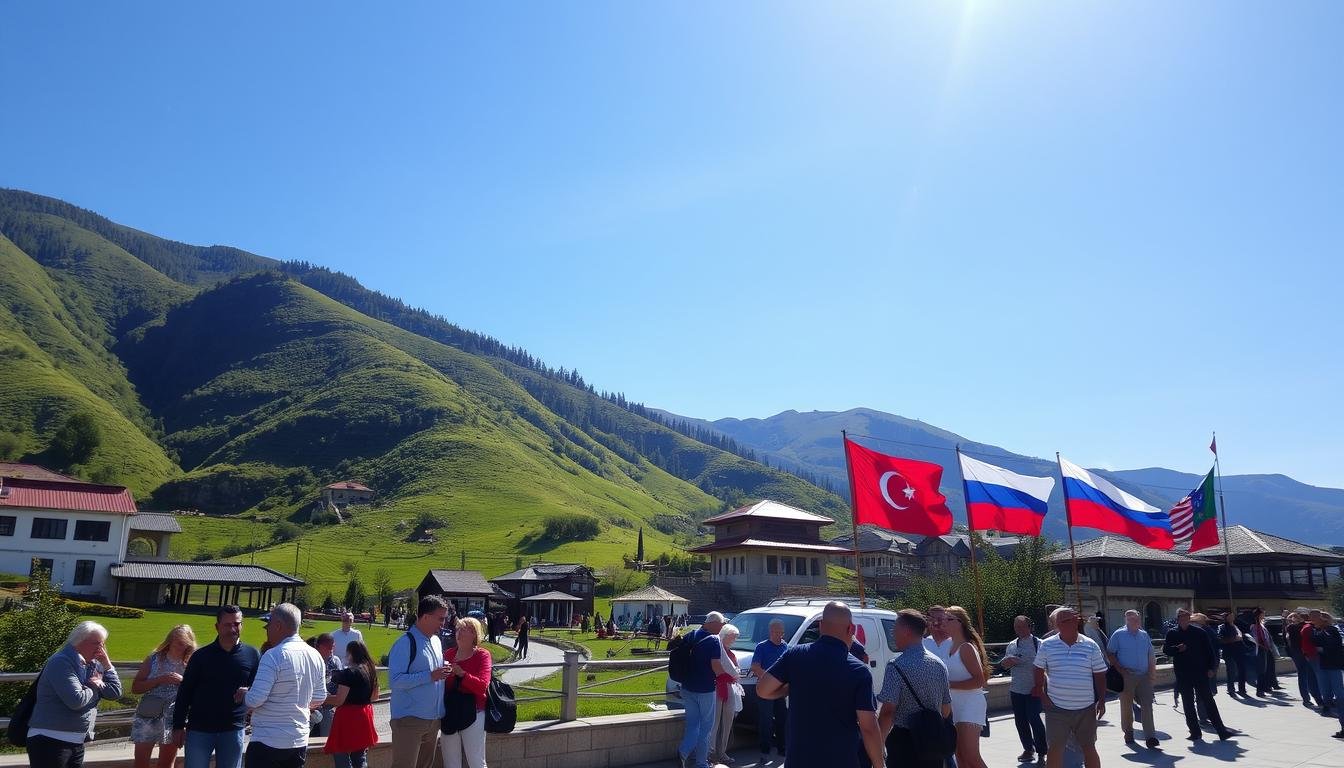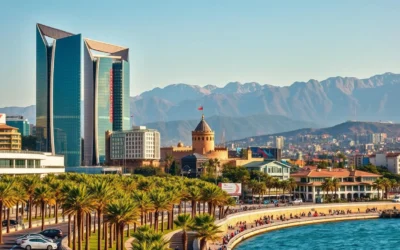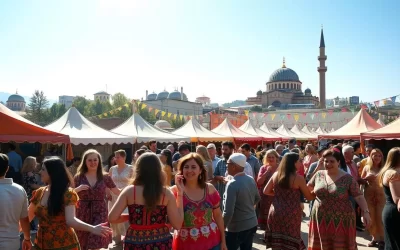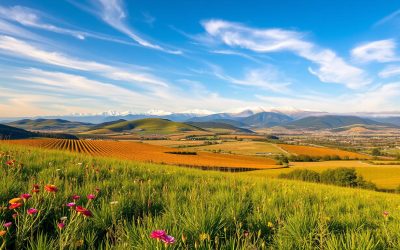✓ Accommodations✓ Flights✓ Rental Cars✓ Tours & Activities
Have you ever thought about how a small country like Azerbaijan can have such a rich mix of languages? The Azerbaijani language shows the nation’s deep cultural roots. It’s the official language and also part of a diverse language scene.
Azerbaijan has a special place for the Azerbaijani language. It’s spoken by over 50 million people worldwide. This language is more than just a way to talk; it connects people across different places.
The official language of Azerbaijan has a story of strength and change. It has kept its core identity through time. It has also taken in words from Russian, English, and other languages.
Key Takeaways
- Azerbaijani is the sole official state language of Azerbaijan
- Over 50 million Azerbaijani speakers exist worldwide
- The language has a rich historical development spanning 1300 years
- Russian and English play significant roles in urban communication
- The linguistic landscape reflects Azerbaijan’s complex cultural history
Overview of Language Diversity in Azerbaijan
Azerbaijan has a rich and diverse language scene. This diversity comes from its location at the crossroads of Eastern Europe and Western Asia. It shows the country’s deep cultural and historical roots.

The country’s many languages come from its mix of ethnic and cultural groups. With over 10 million people, Azerbaijan has a complex language policy. It includes many different languages.
Historical Language Development
Azerbaijan’s language history is filled with cultural exchanges. The main language, Azerbaijani, is part of the Turkic language family. It has been shaped by:
- Persian historical interactions
- Russian colonial periods
- Arabic and Ottoman Turkish influences
Current Linguistic Landscape
Today, Azerbaijan’s language scene is very diverse. Here’s a look at who speaks what:
- Azerbaijani: Primary language for 82% of citizens
- Russian: Spoken fluently by approximately 38% of the population
- Minority languages representing various ethnic groups
Constitutional Status of Languages
Azerbaijan’s language policy makes Azerbaijani the official language. But it also values linguistic diversity. The constitution protects the rights of minority language speakers. This shows a commitment to preserving culture.
“Language is the roadmap of a culture. It tells you where its people come from and where they are going.” – Rita Mae Brown
Even though Azerbaijan hasn’t signed the European Charter for Regional or Minority Languages, it still supports linguistic diversity. This shows a forward-thinking approach to language.
The Azerbaijani Language: Primary National Language

The Azerbaijani language is at the heart of Azerbaijan’s identity. It connects 92.5% of the people through a rich heritage. This language is found in all parts of Azerbaijani life, from government to daily talks.
Learning Azerbaijani gives us a peek into the country’s culture. Here are some key traits of this unique language:
- Turkic language family origin
- Close linguistic relationship with Turkish
- Two primary varieties: North and South Azerbaijani
- Latin script used in Azerbaijan
Interestingly, more than half of Azerbaijani speakers are monolingual, showing the language’s deep cultural value. It brings people together and keeps the national heritage alive.
“Language is the roadmap of a culture. It tells you where its people come from and where they are going.” – Rita Mae Brown
With about 24 million native speakers, Azerbaijani is more than just a national language. It’s official in Azerbaijan and Dagestan. Universities in the U.S., like Indiana University and UCLA, now teach it, making it more global.
Russian Language Influence and Usage
The Russian language is a big part of Azerbaijan’s culture and communication. It shows a deep history that spans many generations. Even though the government wants to focus more on Azerbaijani, Russian is still very important.

The relationship between Russian and Azerbaijani languages is complex and interesting. Today, over 150,000 people in Azerbaijan speak Russian as their first language. There are also 258 million Russian speakers around the world.
Role in Education System
Russian language education in Azerbaijan is strong. About 160,000 kids learn in Russian, which is a big part of the education system. Here are some key points:
- Over 300 schools teach in Russian
- 18 local high schools and 38 specialized secondary schools have Russian programs
- Class sizes can be up to 48 students
Urban vs Rural Usage Patterns
How people use Russian language changes a lot between cities and rural areas. Multilingualism is more common in cities. There, the Russian-speaking community is mostly among the educated class.
“The Russian language remains a silent bridge connecting generations in Azerbaijan” – Linguistic Researcher
Historical Context
The story of Russian language in Azerbaijan is complex. The first Russian-Azeri school opened in 1887, before the Soviet era. By 1970, about 57,500 Azeris said Russian was their native language.
Even though the government is pushing for more Azerbaijani, Russian still holds a special place. It acts as a secret language for communication and education.
Minority Languages in Azerbaijan

Azerbaijan is home to many languages besides Azerbaijani. These minority languages show the country’s rich cultural and ethnic mix. They add to the nation’s unique cultural mosaic.
Minority languages in Azerbaijan include several ethnic groups and their native tongues:
- Lezgian: Spoken by approximately 2.02% of the population
- Talysh: Around 200,000 speakers, representing 1.26% of Azerbaijanis
- Avar: Comprising about 0.56% of the population
- Tat: Estimated 10,000 speakers
Each minority language holds deep cultural value. Linguistic diversity in Azerbaijan is more than just talking. It’s about keeping unique cultural identities alive. Some languages are at risk, with UNESCO listing them as endangered.
“Language is the roadmap of a culture. It tells you where its people come from and where they are going.” – Rita Mae Brown
Azerbaijani is the main language, but minority languages are vital for ethnic heritage. The government is now recognizing the need to protect these languages.
Exploring minority languages reveals Azerbaijan’s rich cultural tapestry. It shows how language diversity enriches the nation’s social and cultural complexity.
Language Policy and Implementation
Azerbaijan’s language policy is a mix of many languages and cultures. It aims to keep cultural heritage alive while meeting today’s educational needs.
Official Language Framework
Azerbaijani is the only official language, showing a strong unity in language. The policy focuses on:
- Promoting Azerbaijani in government and public places
- Protecting the rights of minority languages
- Creating strong language education plans
Statistical Language Distribution
Azerbaijan’s language scene is very diverse. Here are some key facts:
- Azerbaijani: Spoken by about 7 million people
- Russian speakers: Around 26% of the population
- Kurdish speakers: About 20% of the population
- Minority languages: Each has its own culture
Educational Language Framework
Education is key in language policy. The education system focuses on:
- Using Azerbaijani as the main teaching language
- Keeping minority languages alive
- Teaching international languages
“Language is the roadmap of a culture. It tells you where its people come from and where they are going.” – Rita Mae Brown
The government wants to keep national identity strong while being open to all cultures. This creates a lively place where all languages are valued.
Endangered Languages and Preservation Efforts
Azerbaijan’s rich language scene is at risk. Many minority languages are close to disappearing. Rare languages like Budukh, Khinalug, and Udi are losing speakers fast.
Looking into these languages’ situation shows us some scary facts:
- Languages such as Khinalug have fewer than 10,000 speakers
- Some minority language communities have populations under 1,000 individuals
- Emigration and modernization speed up language loss
“Preserving linguistic diversity is not just about words, but about maintaining cultural identity”
Efforts to save these languages are underway. Linguists and community leaders are doing their best to:
- Create detailed language records
- Make educational materials
- Help languages pass from one generation to the next
- Spread the word about linguistic heritage
Azerbaijan knows how vital it is to protect its minority languages. The government and schools work together. They study and support these languages, making sure their cultural voices are heard.
Foreign Language Education and Trends
Azerbaijan’s language scene is changing fast. There’s a big push for speaking many languages and being good at global communication. This shows how education in foreign languages is getting better and more connected.
In Azerbaijan, education is moving towards teaching more languages. About 60% of students are learning English. This shows the country wants to connect with the world more.
English Language Learning Dynamics
Learning English is very important for young people in Azerbaijan. Students are working hard to get better at speaking. Here are some key points about English learning:
- Many students want to get international language certificates.
- There’s a big need for English classes in schools.
- Knowing many languages can really help your career.
International Language Schools
More international language schools are opening in Azerbaijan. These schools help a lot by:
- Teaching special language skills.
- Using international school standards.
- Starting cultural exchange programs.
Business Communication Needs
The economy is changing fast, making language skills even more important. Multilingualism is a big plus for jobs in Azerbaijan. Companies want workers who can talk to people all over the world.
“Language is the road map of a culture. It tells you where its people come from and where they are going.” – Rita Mae Brown
Exploring education in Azerbaijan shows a new way of learning languages. It’s all about getting ready for a world where we all connect. The country is investing in language skills to keep its workers strong and ready for anything.
Language Rights and Cultural Identity
Language rights show how complex cultural identity is in Azerbaijan. The country’s language mix shows a balance between main and minority languages. This balance is key to keeping culture alive and the nation united.
Azerbaijan handles minority languages with care. It aims to keep the country united while valuing language diversity. This approach helps protect the country’s cultural heritage.
“Language is the roadmap of a culture. It tells you where its people come from and where they are going.” – Rita Mae Brown
Important parts of language rights in Azerbaijan include:
- Constitutional protections for linguistic diversity
- Recognition of minority language speakers’ cultural rights
- Efforts to document and preserve endangered languages
The ethnic makeup of Azerbaijan shows why language policy is crucial:
| Ethnic Group | Population Percentage | Approximate Number |
|---|---|---|
| Azerbaijani (Azeri) | 94.8% | 9,480,000 |
| Lezgins | 1.7% | 167,600 |
| Talysh | 0.9% | 87,600 |
| Russians | 0.7% | 71,000 |
Despite efforts, full language rights are still a challenge. The government hasn’t signed the European Charter for Regional or Minority Languages. This decision shows the tough balance between national identity and language diversity.
Learning about language policy in Azerbaijan shows a place where culture and unity meet. This creates a unique world of languages.
Conclusion
Your journey through Azerbaijan’s language shows a rich cultural heritage. With about 30 million speakers, it’s more than just talking—it’s about identity and strength. Azerbaijan’s mix of old and new shows a society that’s always changing.
The Azerbaijani language is a symbol of keeping culture alive. From the Baku dialect in government to the many dialects across the country, it keeps growing. Despite global changes, schools and cultural events help keep the language alive for the young.
Exploring Azerbaijan’s languages, you see a nation balancing many tongues. Azerbaijani, Russian, English, and minority languages mix in a unique way. Efforts to save these languages show Azerbaijan’s pride and strength.
Understanding Azerbaijan’s language is more than just words. It opens a door to the country’s heart. From Baku’s busy streets to Iran and Turkey, Azerbaijani connects people, keeps traditions alive, and shares a story of language strength.
The above is subject to change.
Check back often to TRAVEL.COM for the latest travel tips and deals.






